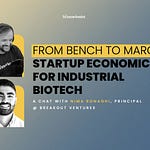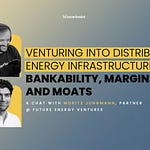Advanced materials are at the forefront of technological innovation, offering solutions that range from building more efficient batteries to creating smarter, more sustainable construction materials.
Despite the revolutionary potential of these materials, the journey from laboratory discovery to commercial success presents significant challenges, especially when scaling is essential for attracting VC investments.
To help decode this complex and exciting topic, we are thrilled to welcome Tony Sun, Director of Corporate Venture Capital at GC Ventures!
Welcome to the 45th episode of Deep Tech Catalyst, the channel by The Scenarionist where science meets venture!
Key Themes Covered:
💡How to Approach Total Addressable Market (TAM) in Advanced Materials
📈 How to Plan Sustainable Growth in Advanced Materials: Near-Term vs. Long-Term Applications
⏳ How Startups Should Align with VC Timelines for Successful Exits
📍Strategic Positioning: How to Identify Your Role in the Supply Chain
🤝 Leveraging the Power of Customer Interviews
BEYOND THE CONVERSATION — REFLECTIONS & STRATEGIC INSIGHTS FROM THE EPISODE
💡How to Approach Total Addressable Market (TAM) in Advanced Materials
Achieving a strong product-market fit in advanced materials isn’t straightforward—it demands a strategic balance between market needs and technological strengths.
There isn’t a one-size-fits-all solution. Usually, there are 2 scenarios to consider.
1. Market Pull
In some cases, innovators begin with a specific market need in mind and then develop solutions around that need. They work to find a customer who aligns with their vision.
Scientists and technologists often focus on solving a particular problem from the start. This approach can serve as a solid foundation for growth.
2. Technology Push
On the other hand, there’s a technology-driven approach. Here, founders might have a unique technology and are looking for the right application or “home” for it.
The key here is not to limit focus to a single sector but instead to consider a list of potential sectors and prioritize.
It’s essential to start with the basics:
What makes your technology unique?
What differentiates it from the rest?
Then, examine macroeconomic trends:
Which sectors are experiencing the highest growth?
Where are the emerging needs?
Finding intersections among these elements is the approach I typically advise for the companies I work with.
Map Your Application Space, Expand Your Market Reach
It’s important to consider a range of different products and aim for a strong product-market fit. Developing and aligning efforts with these applications is essential.
First, it’s crucial to understand the application’s needs—the problem you’re aiming to solve.
Secondly, recognize that persistence is essential. Out of the five or ten applications you may develop over several years, expect only one or two to succeed; most won’t. Accepting this reality and committing to consistent iteration is key.
Regarding various applications, it’s also important to acknowledge that application spaces often fragment quickly. Many of the products you mentioned typically have relatively small markets individually.
However, by combining these applications—whether five, seven, or ten—you achieve a much larger total addressable market (TAM).
Venture capitalists usually look for technological solutions with the potential to create this substantial TAM, even if it’s through combining several smaller application markets.
📈 How to Plan Sustainable Growth in Advanced Materials: Near-Term vs. Long-Term Applications
The ideal approach for deep tech startups focused on advanced materials is to identify two main groups of tech applications:
The first group consists of near-term, achievable, high-margin applications, with the primary goal of validating the technology.
For example, if you’re working with a new chemistry, it doesn’t need to work universally but should succeed in at least one specific context. This approach allows the company to develop a profitable, project-level application with the potential to become self-sustaining.
Given the long development cycles and complex supply chains in advanced materials, it’s crucial for startups to establish a self-sustaining project that extends their runway and ensures survival until products reach end users.
This initial group of applications serves to validate the technology, demonstrate profitability, and increase the company’s resilience, paving the way for the second group of applications.
The second group includes what I call “moonshot” applications—truly disruptive innovations that have the potential to transform the industry and significantly increase the total addressable market (TAM). The goal is to first validate the technology, and then build toward these transformative opportunities.
Start by Understanding Your Potential Customer
In customer interviews, the key is to understand where each product fits within your application space. When speaking to customers, consider how each product aligns with these two categories, and structure your questions accordingly.
A customer interview isn’t just about getting answers—it’s about understanding the potential TAM for each application, the achievable margins, and your team’s capability to deliver within the desired timeline.
Structuring interviews this way gives founders greater clarity to differentiate between near-term and long-term opportunities, helping them allocate resources strategically.
⏳ How Startups Should Align with VC Timelines for Successful Exits
Corporate venture capital (CVC) funds tend to have a slightly longer perspective compared to financial VCs. However, in the traditional VC model, a typical fund operates on a 10-year cycle.
The first five years are primarily for initial investments, while the second half focuses on follow-on investments and preparing for exits. Within this 10-year period, general partners (GPs) are expected to generate returns for their limited partners (LPs), the investors in the fund.
So, if you’re a startup meeting with a VC fund in its second year, consider that any project you’re starting will need to reach an exit event within roughly eight years.
Ideally, you’ll want to have a roadmap targeting an exit in years six or seven to allow for a buffer period if market conditions shift. This provides a year or two of flexibility to adapt as needed.
In an ideal scenario, aim to plan for an exit event around the six- or seven-year mark, with the goal of completing the exit within eight to ten years.
📍Strategic Positioning: How to Identify Your Role in the Supply Chain
One common pitfall is failing to grasp the complexities of the supply chain early on.
Often, considerable effort goes into developing technology around a specific metric, only to later realize that the intended customers aren’t the actual end-users or payers.
This is an error that founders must aim to avoid.
Here are some tips to overcome this common pitfall.
A Practical Example
Suppose you’ve developed a new chemistry that enhances adhesion between chemical groups—perhaps a new polymer.
While this technology might improve a key feature, like adhesion, this polymer is typically just one ingredient in a larger adhesive formulation. This formulation then needs to reach customers who will apply it to a product.
Ultimately, the actual end-users—those interacting with the final product—may not be paying customers but still determine all the key performance indicators (KPIs) and specifications the product must meet.
Early-stage technologists often focus on specific metrics without understanding the broader requirements, like coating formulation nuances or the end requirements of the application.
For instance, is the coating intended for food contact, medical use, electronics, or industrial purposes?
Different applications have distinct standards, such as temperature resistance, which can make or break a product’s success. Improving adhesion alone won’t suffice if it doesn’t meet these broader application needs.
Identify the Main Capability Gaps
Moreover, it’s essential to identify capability gaps and decide where you want to position yourself within the supply chain.
Would you prefer to be an ingredient supplier, a formulation provider, or a full-solution provider?
This choice influences whether to invest in in-house capabilities, such as production lines and specialized staff or to partner with established companies.
For example, you might choose to be a polymer supplier and partner with an adhesive company through a joint development agreement, leveraging their expertise and network. Alternatively, you might hire a team to develop your own formulation, positioning yourself to compete directly.
These strategic business decisions early on will ultimately guide your development approach. Addressing these considerations proactively can help avoid the pitfalls many companies encounter.
🤝 Leveraging the Power of Customer Interviews
The advanced materials industry is highly fragmented, with each application or sector having its own unique dynamics, which can vary significantly. Generally, attending industry events can be invaluable for staying informed and meeting potential customers.
"When you're doing customer interviews, don't just treat your customer as a customer; also treat them as a friend, as a potential advisor. Ask them about the supply chain. Ask who the decision-makers are, who the actual paying customers are, and how the decision is being made. Try to embed some of these questions in your customer interview, as they will help a lot."
As VCs, we don’t expect someone fresh out of school to have all this knowledge immediately.
It’s a process of learning by doing and doing by learning.
Attend events, listen to industry podcasts (like this one!), and engage in continuous learning. There isn’t a single source or individual who can answer every question.
Instead, build knowledge incrementally over time, consistently expanding your understanding over one, two, or even several years. Even industry veterans with 30 or 40 years of experience are constantly adapting to new trends. Consistent, open-minded learning is key.











